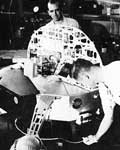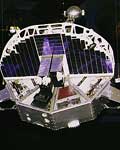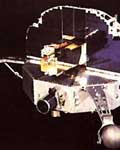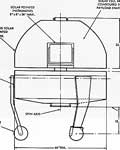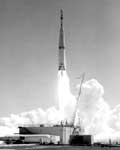OSO-1
Orbiting Solar Observatory-1

Spacecraft
The OSO-1 spacecraft was designed primarily as a stabilized platform for solar-oriented scientific instruments. In addition, experiments not requiring fixed orientation with respect to the sun were housed in the spinning wheel section of the satellite. Electrical power was supplied by an array of solar cells mounted on the stabilized section. A complete telemetry and command system was provided to transmit information back to earth.
The satellite has two main sections: the fan-shaped stabilized section to which the solar array and pointed instruments are attached, and the lower spinning wheel section that housed the rest of the instruments as well as the spacecraft subsystems. Three glass-fiber spheres on extensible arms hold pressurized nitrogen gas for the spin control system. The two main structures are connected by an aluminum shaft running from the base of the solar cell assembly through the center of the wheel section and ending in the support ring structure on the underside of the wheel. Mounted on the base of the shaft is a slip-ring assembly allowing transmission of power, telemetry signals, and control signals from the stabilized section to the spinning wheel.
The wheel diameter was 44 inches and with the extensible arms extended the diameter was increased to 92 inches. The overall height is 37 inches and total weight was about 440 pounds.
OSO-1 Information
Mission Objectives
Spacecraft
Gamma-ray Experiment
Results
Publications
